 |
JAVA: Meta Data |
| << JAVA: Result Set |
| Java Graphics >> |
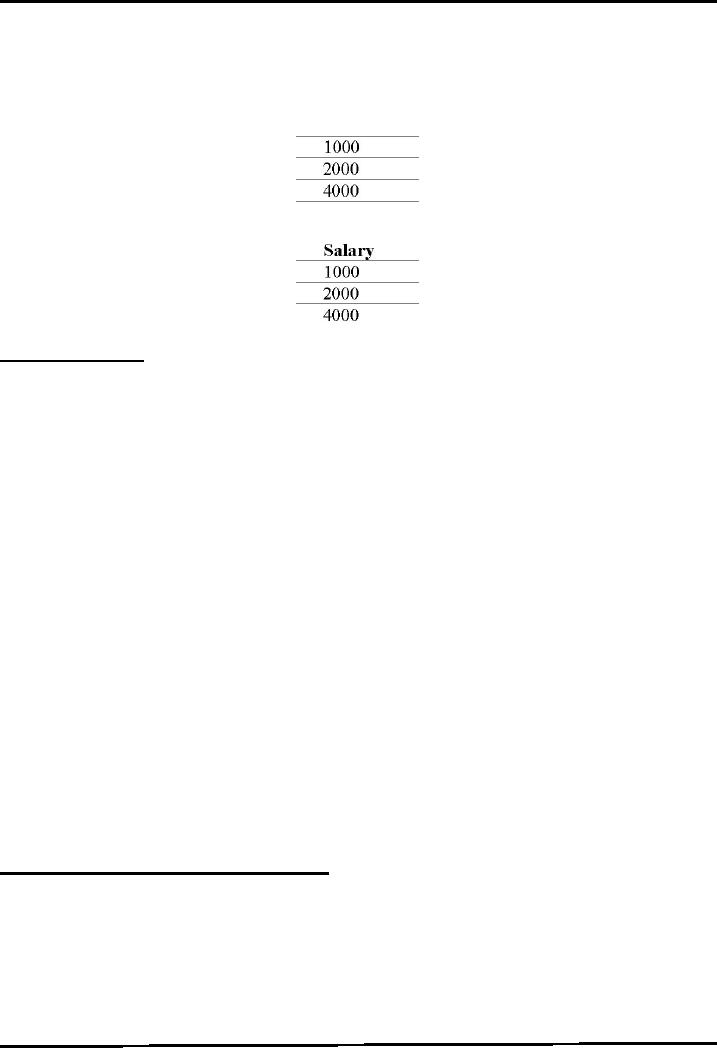
Web
Design & Development CS506
VU
Lesson
17
Meta
Data
In
simple terms, Meta Data is
data (information) about data.
The actual data has no
meaning without
existence of
Meta data. To clarify this,
let's look at an example.
Given below are listed
some numeric
values
What
this information about? We cannot state
accurately. These values might be
representing some one's
salaries,
price, tax payable &
utility bill etc. But if we
specify Meta data about
this data like shown
below:
Now,
just casting a glance on these values,
you can conclude that it's
all about some ones
salaries.
ResultSet
Meta data
ResultSet
Meta Data will help you in
answering such questions
-How
many columns are in the
ResultSet?
-What
is the name of given
column?
-Are
the column name case
sensitive?
-What
is the data type of a specific
column?
-What
is the maximum character size of a
column?
-Can
you search on a given
column?
Creating
ResultSetMetaData object
From
a ResultSet (the return type of
executeQuery() ), derive a
ResultSetMetaData object by
calling
getMetaData()
method as shown in the given code snippet (here
rsis a valid ResultSetobject):
ResultSetMetaData
rsmd = rs.getMetaData();
Now,
rsmd can be used to look up
number, names & types of columns
Useful
ResultSetMetaData methods
.
getColumnCount
( )
Returns
the number of columns in the result
set
.
getColumnDisplaySize
(int)
Returns
the maximum width of the specified
column in characters
.
getColumnName(int)
/ getColumnLabel (int)
The
getColumnName() method returns the database
name of the column
The
getColumnLabel() method returns the suggested
column label for
printouts
.
getColumnType
(int)
Returns
the SQL type for the column
to compare against types in
java.sql.Types
Example
Code 17.1: Using
ResultSetMetaData
The
MetaDataEx.java will print
the column names by using
ResultSetMetaData object and column
values
on console.
This is an excellent example of the
scenario where we have no idea about the
column names in
advance
Note:
For
this example code and
for the coming ones, we are
using the same database
(PersonInfo) the one
we
created earlier and
repeatedly used. Changes are
shown in bold face
1
//
File MetaDataEx.java
2
import
java.sql.*;
3
public
class MetaDataEx {
4
public
static void main (String args[ ])
{
133

Web
Design & Development CS506
VU
5
try
{
6
//Step
2: load driver
7
Class.forName("sun.jdbc.odbc.JdbcOdbcDriver");
8
//Step
3: define the connection
URL
9
String
url = "jdbc:odbc:personDSN";
10
//Step
4: establish the connection
11
Connection
con = null;
12
con =
DriverManager.getConnection(url, "",
"");
13
//Step
5: create PrepareStatement by passing
sql and
14
// ResultSet
appropriate fields
15
String
sql = "SELECT * FROM
Person";
16
PreparedStatement
pStmt = con.prepateStatement(sql,
17
ResultSet.TYPE_SCROLL_INSENSITIVE,
18
ResultSet.CONCUR_UPDATABLE);
19
//Step
6: execute the query
20
ResultSet
rs = pStmt.executeQuery();
21
// get
ResultSetMetaData object from
rs
22
ResultSetMetaData
rsmd = rs.getMetaData( );
23
//
printing no. of column
contained by rs
24
int
numColumns =
rsmd.getColumnCount();
25
System.out.println("Number
of Columns:" + numColumns);
26
//
printing all column names by
using for loop
27
String
cName;
28
for(int
i=1; i<= numColumns; i++)
{
29
cName =
rsmd.getColumnName(i);
30
System.out.println(cName);
31
System.out.println("\t");
32
}
33
//
changing line or printing an
empty string
34
System.out.println("
");
35
//
printing all values of ResultSet by
iterating over it
36
String
id, name, add, ph;
37
while(
rs.next() )
38
{
39
id =
rs.getString(1);
40
name
= rs.getString(2);
41
add =
rs.getString(3);
42
ph =
rs.getString(4);
43
System.out.println(id);
44
System.out.println("\t");
45
System.out.println(name);
46
System.out.println("\t");
47
System.out.println(add);
48
System.out.println("\t");
49
System.out.println(ph);
50
System.out.println("
");
51
}
52
//Step
8: close the connection
53
con.close();
54
}catch(Exception
sqlEx){
55
System.out.println(sqlEx);
56
}
57
} // end
main101.} // end class
134
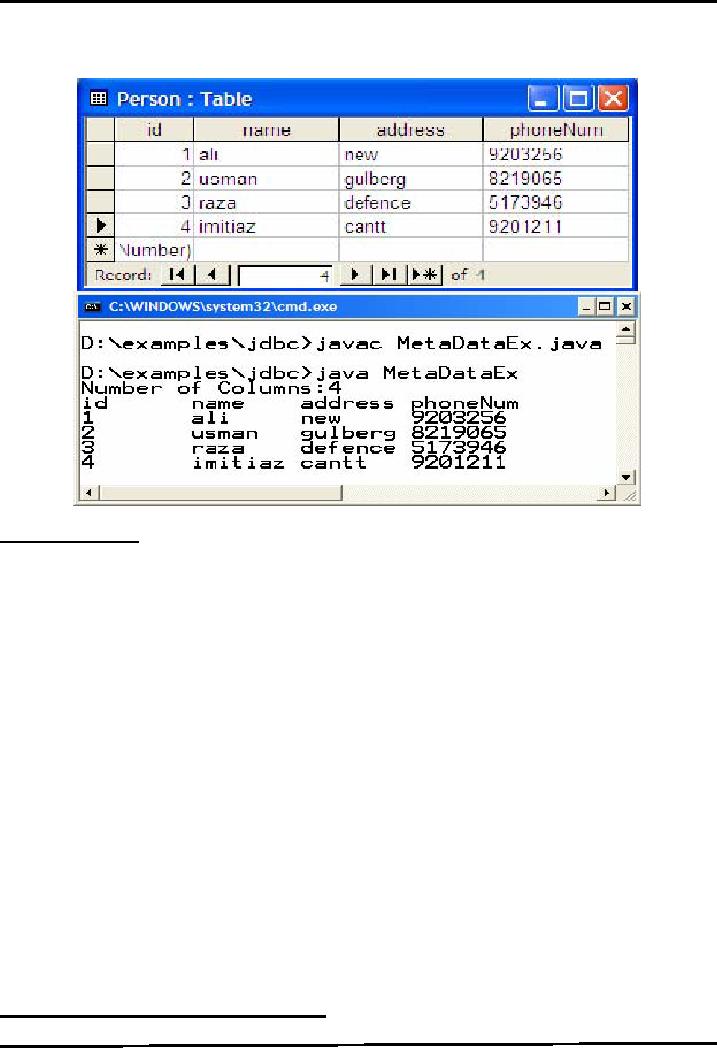
Web
Design & Development CS506
VU
Compile
& Execute:
The
database contains the following values at the
time of execution of this
program. The database and
the
output
are shown below:
DataBaseMetaData
DataBase
Meta Data will help you in
answering such questions
What
SQL types are supported by DBMS to
create table?
What
is the name of a database
product?
What
is the version number of this database
product?
What
is the name of the JDBC driver
that is used?
Is the
database in a read-only
mode?
Creating
DataBaseMetaData object
From
a Connection object, a DataBaseMetaData
object can be derived. The
following code
snippet
demonstrates
how to get DataBaseMetaDataobject.
Connection
con= DriverManager.getConnection(url, usr,
pwd);
DataBaseMetaData
dbMetaData =
con.getMeataData();
Now,
you can use the dbMetaData
to gain information about the
database.
Useful
ResultSetMetaData methods
. getDatabaseProductName(
)
Returns the name of the database's
product name
. getDatabaseProductVersion(
)
Returns the version number of this
database product
. getDriverName(
)
Returns the name of the JDBC
driver used to established the
connection
. isReadOnly(
)
Retrieves
whether this database is in
read-only mode
Returns true if so, false
otherwise
Example
Code 17.2: using
DataBaseMetaData
This
code is modification of the example
code 17.1. Changes made
are shown in bold
face.
135
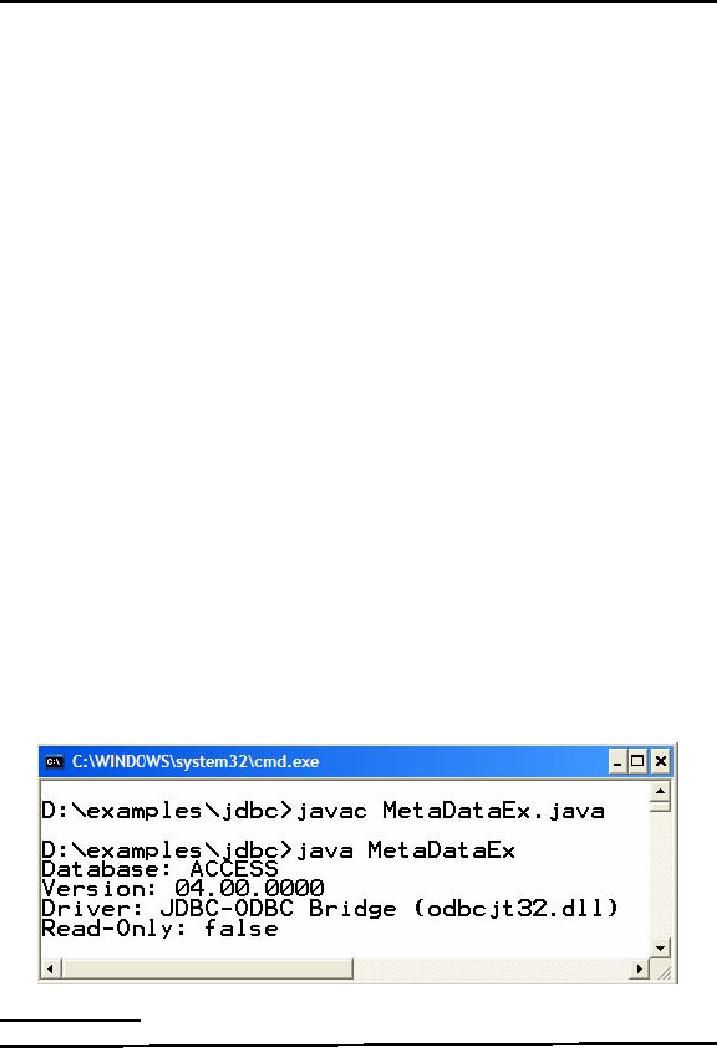
Web
Design & Development CS506
VU
102.//
File MetaDataEx.java 103.import
java.sql.*; 104.public class
MetaDataEx {
105.
public static void main
(String args[ ]) {
106.
try {
107.
//Step 2: load
driver
108.
Class.forName("sun.jdbc.odbc.JdbcOdbcDriver");
109.
//Step 3: define the connection
URL
110.
String url =
"jdbc:odbc:personDSN";
111.
//Step 4: establish the
connection
112.
Connection con =
null;
113.
con = DriverManager.getConnection(url, "",
"");
114.
// getting DataBaseMetaDat
object
115.
DataBaseMetaData
dbMetaData =
con.getMetaData();
116.
// printing database product
name
117.
Sring
pName =
dbMetaData.getDatabaseProductName();
118.
System.out.println("DataBase:
" + pName);
119.
// printing database product
version
120.
Sring
pVer =
dbMetaData.getDatabaseProductVersion();
121.
System.out.println("Version:
" + pVer);
122.
// printing driver name
used to establish connection &
123.
// to retrieve data
124.
Sring
dName =
dbMetaData.getDriverName();
125.
System.out.println("Driver:
" + dName);
126.
// printing whether database is
read-only or not
127.
boolean
rOnly =
dbMetaData.isReadOnly();
128.
System.out.println("Read-Only:
" + rOnly);
129.
// you can create &
execute statements and
can
130.
// process results over
here if needed
131.
//Step 8: close the
connection
132.
con.close();
133.
}catch(Exception sqlEx){
134.
System.out.println(sqlEx);
135.
}
136.
} // end main
} //
end class
137.
Compile
& Execute
On
executing the above program, the
following output will
produce:
JDBC
Driver Types
JDBC
Driver Types are divided
into four types or
levels.
136
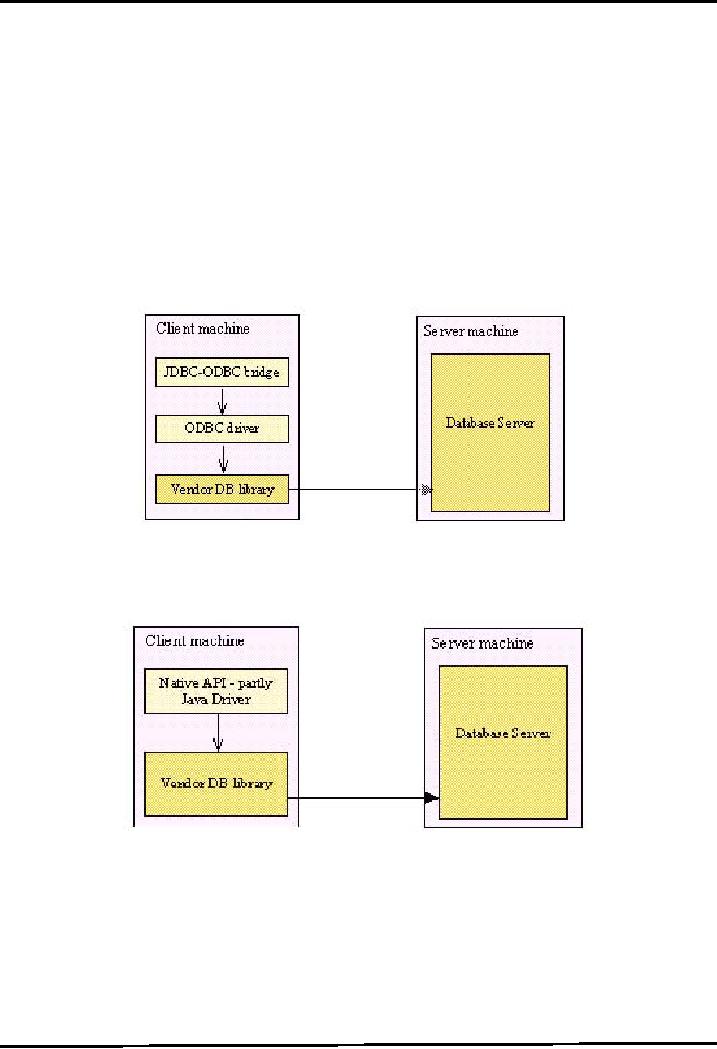
Web
Design & Development CS506
VU
Each
type defines a JDBC driver
implementation with increasingly
higher level of
platform
independence,
performance, deployment and
administration.
The
four types are:
Type
1: JDBC ODBC
Bridge
Type
2: Native API/partly Java
driver
Type
3: Net protocol/allJava
driver
Type
4: Native protocol/allJava
driver
Now,
let's look at each type in
more detail
Type
1: JDBC ODBC
Bridge
-Translates
all JDBC calls into ODBC
(Open Database
Connectivity)
calls and send them to the ODBC Driver
-
Generally
used for Microsoft database.
-Performance is
degraded
4. Type
2: Native API/partly Java
driver
-Converts
JDBC calls into database-specific calls
such as SQL Server, Informix, Oracle or
Sybase.
-Partly-Java
drivers communicate with database-specific API
(which may be in C/C++)
using the Java
Native
Interface.
-Significantly
better Performance than the
JDBC-ODBC bridge
4. Type
3: Net protocol/allJava
driver
-Follows
a three-tiered approach whereby the JDBC
database requests ()are passed
through the network to
the
middle-tier server
-Pure
Java client to server
drivers which send requests
that are not
database-
specific
to a server that translates them
into a database-specific protocol. . -If
the middle-tier server is
written
in java, it can use a type
1or type 2JDBC
driver
to do
this
137
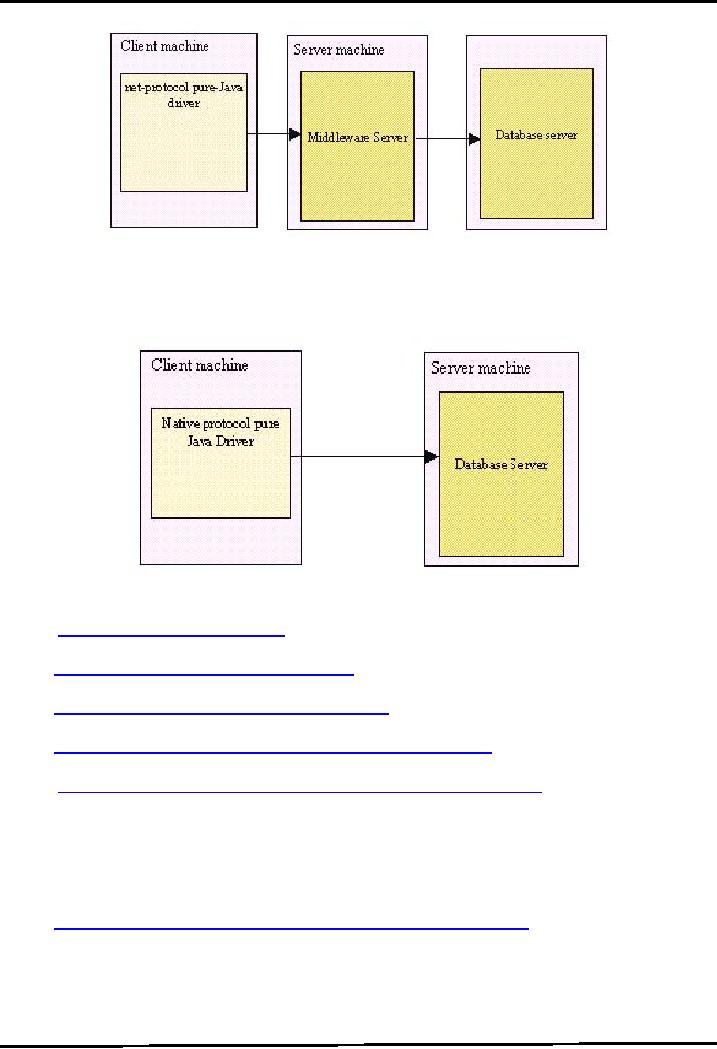
Web
Design & Development CS506
VU
4. Type
4: Native protocol / all java
driver
-Converts
JDBC calls into the vendor-specific
DBMS protocol so that client
application can communicate
directly
with the database
server
-Completely
implemented in Java to achieve platform
independence and eliminate deployment
issues.
-Performance is
typically very good
On
Line Resources
· Sun's
JDBC Site
http://java.sun.com/products/jdbc/
· JDBC
Tutorial
http://java.sun.com/docs/books/tutorial/jdbc/
· List
of available JDBC Drivers
http://industry.java.sun.com/products/jdbc/drivers/
· RowSet
Tutorial
http://java.sun.com/developer/Books/JDBCTutorial/chapter5.html
· JDBC
RowSets Implementation
Tutorial
http://java.sun.com/developer/onlineTraining/
Database/jdbcrowsets.pdf
References:
· Java
API documentation 5.0
· Java
A Lab Course by Umair
Javed
· JDBC
drivers in the wild
http://www.javaworld.com/javaworld/jw-07-2000/jw-0707-jdbc_p.html
138
Table of Contents:
- JAVA FEATURES
- Java Virtual Machine & Runtime Environment
- Learning Basics of JAVA
- JAVA: Object Oriented Programming
- JAVA: Inheritance
- JAVA: Collections
- JAVA: Intro to Exceptions
- JAVA: Streams
- JAVA: Modification of Address Book Code
- JAVA: Graphical User Interfaces
- JAVA: Event Handling
- JAVA: More Examples of Handling Events
- JAVA: Problem in Last Code Example
- Java Database Connectivity
- JAVA: More on JDBC
- JAVA: Result Set
- JAVA: Meta Data
- Java Graphics
- JAVA: How to Animate
- JAVA Applets
- JAVA: Socket Programming
- JAVA: Serialization
- JAVA: Multithreading 1
- JAVA: Multithreading 2
- JAVA Web Application Development
- Java Servlets
- JAVA: Creating a Simple Web Application in Tomcat
- JAVA: Servlets Lifecycle
- JAVA: More on Servlets
- JAVA: Dispatching Requests
- JAVA: Session Tracking 1
- JAVA: Session Tracking 2
- JAVA: AddressBook Case Study Using Sevlets
- Java Server Pages 1
- JavaServer Pages 2
- Java Server Pages 3
- JAVA: JSP Action Elements and Scope
- JAVA: JSP Custom Tags
- JAVA: MVC + Case Study
- JAVA: MVC Model 2 Architecture
- JAVA: Layers and Tiers
- JAVA: Expression Language
- JAVA: JavaServer Pages Standard Tag Library (JSTL)
- JAVA: Client Side Validation & JavaServer Faces (JSF)
- JAVA: JavaServer Faces